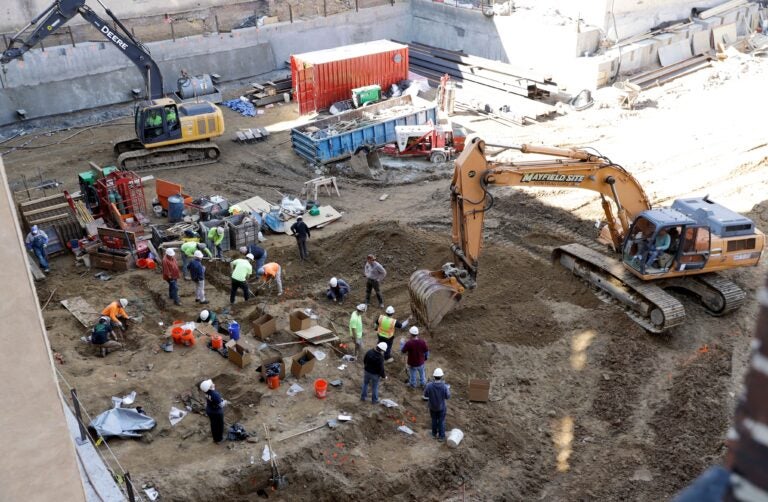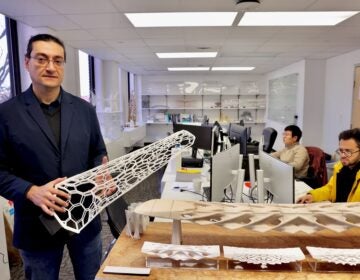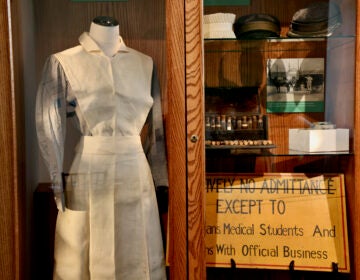Human remains discovered at Philly construction site 8 years ago have been reburied, but issues still persist
Workers in Philly's Old City hit upon a historic cemetery with hundreds of people. It took years to study, identify and rebury them.
Listen 5:32
Workers excavate coffins from a construction site in the Old City neighborhood, Thursday, March 9, 2017, in Philadelphia. Crews working on an apartment building in Philadelphia’s historic district got a shock last month when their backhoes started hitting coffins and unearthing fully intact human remains. The site was supposed to be a former burial ground from 1707, and all remains were supposedly exhumed in the 1800s and moved to a different cemetery. (AP Photo/Matt Slocum)
From Philly and the Pa. suburbs to South Jersey and Delaware, what would you like WHYY News to cover? Let us know!
The arguments over hundreds of bodies found during a Philadelphia construction project are still not over.
Now that the bodies have finally been reburied at a cemetery, there are new objections to how the burials and some of the research were handled.
Construction leads to surprise 2016 discovery
At first, construction workers working on an apartment building on Arch Street thought they hit a few graves, but it turns out they had hit hundreds.
The site was a former cemetery belonging to the historic First Baptist Church of Philadelphia — and the bodies and coffins they found were more than 200 years old.
There was confusion as to what to do next. Various government agencies said they did not have jurisdiction over human remains found on private property. Archaeologists quickly organized to volunteer their time, so someone could always be on site to document what the workers were finding, to prevent further damage.
Kimberlee Moran, a forensic archaeologist at Rutgers University-Camden, was part of the effort from the start. She recalled seeing a two-story deep hole propped up with pillars of soil.
“Those slender pillars of soil were just chock full of coffins that had been ripped open by whatever excavating machinery had dug that giant hole,” she said.
Research begins
Moran and other researchers petitioned Philadelphia’s Orphans’ Court, to get more time to study and identify the people who were buried. A judge ordered the developer, PMC Property Group, to work with archaeologists from a consulting firm, AECOM, to transport the remains to Rutgers so researchers could preserve and identify them, and cover the cost of reburial.
“I truly believe that this is a public archaeology project,” Moran said. “This happens smack in the middle of the city … it is our responsibility to inform the public about what is under their feet. And what they can learn from the people that lived here 100, 200 years before them.”
Students worked on the artifacts and human remains from the site. They shared their findings in blog posts and at a public forum two years ago.
How the bodies got there
One of the early findings was that the First Baptist Church was supposed to move the bodies in their cemetery to Mount Moriah Cemetery in the 19th century, but did not finish the job.
“They had three months in the middle of winter with 1860s technology to try to dig up thousands of people and relocate them,” Moran explained. “Essentially they just did … the best they could with the time that they had and called it a day.”
The court gave Moran and other researchers until late 2023 to finish studying the human remains and rebury them. All the while, they worked with the First Baptist Church and Mount Moriah Cemetery and stayed in touch with descendants of the people buried.
“At every stage, we’ve interacted with the existing First Baptist Church to make sure that everything that we do is okay with them,” Moran said.
David McCann, a descendent of Samuel Miles, a former mayor of Philadelphia and Revolutionary War veteran who is buried in the cemetery, said he appreciated the work that Moran and her team did to deal with the developer, construction workers, and the court, while keeping him and other descendants informed.
“I really admire … the steadfastness of Professor Moran to stay the course,” he said.
Kathryn Hartmann is another descendant, who, like McCann, describes herself as a family history enthusiast.
“I really do have to give a shout-out to Dr. Moran for keeping all of the lay people apprised of what’s going on,” Hartmann said. “She could easily have ignored our interests.”
Conflict arises as bodies are supposed to be reburied
The reburial was scheduled for late 2023. But a few months before that, the Philadelphia Archaeological Forum, a group that had been part of the effort, accused Moran and other researchers of being unethical.
In a court filing, the forum compared the research project to how the Penn Museum had kept remains from the 1985 MOVE bombing, where the police dropped a bomb on a West Philadelphia neighborhood. In that case, it turned out that an anthropologist had kept some of the remains and used them in classes.
The Philadelphia Archaeological Forum complained to the court, saying that what Moran and other researchers did is “highly reminiscent” of how the Penn Museum handled the MOVE remains, because they did not care for the deceased respectfully. The forum said Moran and other researchers used the human remains as “unauthorized teaching tools” to advance their own careers.
“It was like all of my worst nightmares were coming true,” Moran said.
Doug Mooney, president of the Philadelphia Archaeological Forum, said he filed the complaint because the researchers had done more with the human remains than what the court had allowed for.
“We felt that it exceeded the authorities that the court had given Rutgers-Camden,” he said.
For instance, the report says the researchers let people who were not authorized to handle the human remains and funerary artifacts handle them, that the researchers collected “unauthorized biological samples”, and that the researchers did not give a detailed plan for the reburial.
Moran said she wrote a 100-page report to the court responding to Mooney’s claims. The judge was satisfied, and this July, they reburied everything from the site at Mount Moriah Cemetery in Southwest Philadelphia, except for some historic trash that people had thrown in the cemetery over the years, like bits of animal bones.
She said she was surprised to see the report from Mooney and the Philadelphia Archaeological Forum, because they had presented their work at conferences together and supported each other.
“I’m sad about it because I really liked Doug. I’ve really enjoyed working with him.”
Mooney replied by saying, “At no point have we worked with Kimberlee. We have had conversations with her at times, but they were not frequent.”
There will be a public ceremony later, with a memorial that the developer will pay for. Both descendants, McCann and Hartmann, said they hope to attend.
But the drama over the site is not over.
The reburial was scheduled for January, but then a snowstorm hit Philadelphia, and it was rescheduled for July. The Philadelphia Archaeological Forum says the reburial was improper because while the developer, PMC Property Management, did give public notice of the reburial as required by the judge, they did not give public notice again for the new date after it was pushed back.
Mooney said the larger issue is that the city does not have laws that clearly state what should happen in cases like this.
“This could all be alleviated by the city, whether it’s by passing an ordinance, which would be … probably the best thing that could happen,” he said.
As an example of how this could have gone better, he pointed to a construction site in 2019 where the developer found human remains, notified Orphans’ Court, and worked with the Philadelphia Archaeological Forum on a plan for how to handle them.
In a statement, a spokesperson for the city law department maintains the city does not have authority over the discovery of private abandoned burial grounds. The consulting firm, AECOM, did not respond to requests for comment. A lawyer representing PMC Property Management said there was no way to have known that the construction site was a historic cemetery, and that they did the best they could to handle a complex situation ethically.
WHYY is your source for fact-based, in-depth journalism and information. As a nonprofit organization, we rely on financial support from readers like you. Please give today.





